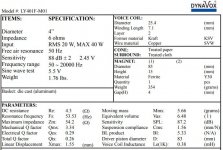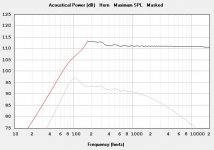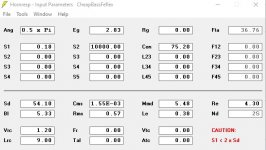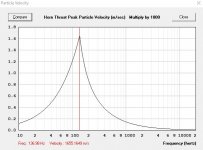I simulated an FLH driven by a couple of dynamic drivers in series. Please let me know your comments and opinions.
Thank you.
Thank you.
Attachments
Last edited:
Please let me know your comments and opinions.
The specified throat area of 0.18 cm^2 (4.24 mm x 4.24 mm) is not realistic.
For one thing, it results in a Sd / S1 compression ratio of more than 300 to 1 🙂.
The specified throat area of 0.18 cm^2 (4.24 mm x 4.24 mm) is not realistic.
For one thing, it results in a Sd / S1 compression ratio of more than 300 to 1 🙂.
I merely calculated the throat area such that the throat perimeter is equal to the wavelength at 20000Hz 🙂
What is an acceptable throat area and ratio for this simulation?
The specified throat area of 0.18 cm^2 (4.24 mm x 4.24 mm) is not realistic.
For one thing, it results in a Sd / S1 compression ratio of more than 300 to 1 🙂.
The throat velocity shows supersonic speeds. What does that translate to, in real life?
Attachments
it results in a Sd / S1 compression ratio of more than 300 to 1.
I just noticed that 2 drivers have been specified, meaning that the compression ratio would be greater than 600 to 1.
A ratio of about 4 to 1 would be more realistic.
I just noticed that 2 drivers have been specified, meaning that the compression ratio would be greater than 600 to 1.
A ratio of about 4 to 1 would be more realistic.
Destruction of the drive units. 😉
Understood!
- Home
- Loudspeakers
- Full Range
- Please critique my dynamic driver based FLH Hornresp simulation



